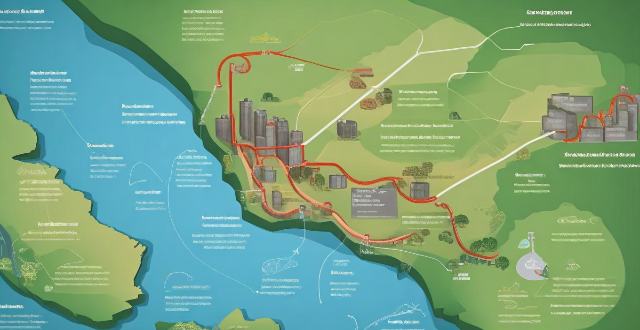Support Countries

How can we balance the needs of developing countries with those of developed countries when it comes to climate action ?
This article explores strategies for balancing the needs of developing and developed countries in climate action. It discusses economic disparities, environmental impact, finance and technology transfer, capacity building, equitable emission reductions, adaptation support, collaborative research and innovation, and policy coherence as key factors to consider. The article emphasizes that achieving a balance requires recognizing the unique circumstances and needs of both types of countries and implementing strategies such as financial support, technology transfer, capacity building, equitable emission reductions, adaptation support, collaborative research, and policy coherence.

What role do developing countries play in climate governance ?
The article discusses the crucial role of developing countries in climate governance, highlighting their vulnerability to climate change, growing greenhouse gas emissions, active participation in international negotiations, innovation and technology transfer, financing and investment needs, and capacity building requirements. It emphasizes that developing countries are essential for achieving a successful outcome in the global fight against climate change.

How do countries measure their progress towards achieving climate goals ?
Countries measure their progress towards achieving climate goals through various indicators and metrics. These include Nationally Determined Contributions (NDCs), greenhouse gas inventories, renewable energy production, carbon intensity, forest cover and land use changes, climate finance flows, policy implementation, and public awareness and participation. By tracking these factors, countries can assess their performance in reducing emissions, adapting to climate impacts, and supporting global efforts to combat climate change.

How do developing countries participate in international climate agreements ?
Developing countries play a crucial role in the global effort to combat climate change. Their participation in international climate agreements is essential for achieving a sustainable future for all nations. This article discusses how developing countries can engage with these agreements and contribute to global climate action by prioritizing education and awareness, seeking technical assistance, accessing financial and technological support, ensuring inclusivity and representation, building capacity through institutional strengthening and training programs, and engaging in collaboration and partnerships. By addressing these key points, developing countries can play a significant role in shaping global climate policy and contributing to a more sustainable future for our planet.

Can developing countries meet the same climate commitments as developed ones ?
Climate change is a global challenge that requires collective action from all countries, regardless of their level of development. However, the question arises: can developing countries meet the same climate commitments as developed ones? This article discusses the differences in economic and technological capabilities, international support and collaboration, and national priorities and policy choices between developed and developing countries. While there are significant differences between the two groups of countries in terms of their ability to meet stringent climate commitments, international support and collaboration can help bridge these gaps. Additionally, national priorities and policy choices play a crucial role in determining whether developing countries can successfully implement climate actions while balancing other developmental goals.

Is cryptocurrency legal in all countries ?
The legality of cryptocurrency varies across countries, withThe legality of cryptocurrency varies across countries, with it and others banning or The United States, Japan, and El Salvador are examples of countries where cryptocurrency is legal and regulated. In contrast, Algeria, Egypt, and Nepal have outright banned it due to concerns over financial stability and potential misuse in illegal activities. China, India, and Russia have imposed restrictions on its use but have not completely prohibited it. It is crucial to understand local laws and regulations before engaging in any cryptocurrency-related activities.

How do climate policies vary between developed and developing countries ?
This article compares the climate policies of developed and developing countries, highlighting differences in economic resources, technological capabilities, and political priorities. Developed countries have larger economies and more financial resources to invest in climate change initiatives, while developing countries face challenges due to limited financial resources. Technological capabilities also differ significantly, with developed countries possessing advanced technologies for renewable energy and emission reduction strategies, while developing countries lack such infrastructure. Political priorities also vary, with developed countries often prioritizing climate action, while developing countries may prioritize other pressing issues. The article concludes that international cooperation and support mechanisms are crucial for bridging these gaps and fostering a global response to climate change that is both equitable and effective.

What are the challenges faced by developing countries in emission reduction ?
Developing countries face numerous challenges in reducing their greenhouse gas emissions, including lack of financial resources, technological constraints, socio-economic factors, policy and regulatory challenges, cultural and educational barriers, and natural resource availability. These challenges highlight the complex nature of emission reduction efforts in developing countries and underscore the need for international cooperation, financial assistance, and technology transfer to support their transition to a low-carbon future.

How are countries working together to combat climate change ?
The text discusses the various international initiatives and agreements aimed at combating climate change, emphasizing the importance of global collaboration in addressing this complex issue. Key points include: 1. **International Agreements** such as the UNFCCC, Kyoto Protocol, and Paris Agreement set the framework for countries to commit to reducing greenhouse gas emissions and limiting global warming. 2. **Multilateral Cooperation** platforms like the Global Green Growth Forum and Clean Energy Ministerial focus on sharing knowledge and promoting sustainable practices. 3. **Financial and Technical Support** mechanisms, including the Green Climate Fund and Adaptation Fund, provide resources for developing countries to tackle climate change effectively. 4. **Research and Development** organizations, including the IEA and IPCC, offer scientific assessments and energy strategies to guide policy decisions. 5. **Education and Public Awareness** programs aim to integrate climate change education into global curricula and raise public awareness about its implications. 6. **Mitigation and Adaptation Strategies**, such as Nationally Appropriate Mitigation Actions (NAMAs) and Integrated Coastal Zone Management (ICZM), help countries adapt to and reduce the impacts of climate change. These efforts underscore the collective action required from nations worldwide to mitigate and adapt to the challenges posed by climate change, ultimately working toward a more sustainable future.

How can countries with different levels of development cooperate on climate change issues ?
Climate change is a global challenge that requires the cooperation of all countries, regardless of their level of development. Here are some ways in which countries with different levels of development can work together on climate change issues: 1. **Sharing Technology and Knowledge**: Developed countries can share clean energy technologies with developing countries, while developing countries can share their indigenous knowledge about sustainable practices with developed countries. 2. **Joint Research and Development**: Countries can collaborate on research projects to develop new technologies and solutions for addressing climate change, and developed countries can provide training and capacity building programs to help developing countries build their scientific and technical capabilities. 3. **Financial Support and Investment**: Developed countries can provide financial assistance to developing countries to help them implement climate change mitigation and adaptation measures, and private sector investors from developed countries can invest in clean energy projects in developing countries. 4. **International Agreements and Cooperation**: Countries can work together under international climate agreements, such as the Paris Agreement, to set targets for reducing greenhouse gas emissions and adapting to the impacts of climate change, and developing countries can also cooperate with each other through South-South cooperation initiatives.

How do international teacher training standards compare across different countries ?
This text is about the differences in teacher training standards across countries. It explains that while there are some common elements to most teacher training programs, such as foundational education and practical experience, there are also significant differences due to factors like cultural influences and funding. The text then goes on to describe these differences in more detail.

What challenges do countries face when trying to achieve climate cooperation ?
**Challenges in Achieving Climate Cooperation:** Countries face numerous challenges when trying to cooperate on climate issues due to diverse national interests, unequal responsibility and capacity, economic implications of climate policies, geopolitical tensions, scientific uncertainty and skepticism, and institutional barriers. These factors can lead to disagreements about who should bear the burden of reducing emissions and how much financial and technical support should be provided to less capable nations. By understanding these challenges, countries can work together to find solutions that balance national interests with the global imperative of combating climate change.

What countries are leading in wind energy production ?
The leading countries in wind energy production are China, the United States, Germany, India, and Spain. China has the largest installed capacity with 282 GW as of 2021, followed by the US with 119 GW, Germany with 60 GW, India with 38 GW, and Spain with 26 GW. These countries have seen rapid growth and innovation in their wind energy sectors, with key regions and states contributing significantly to their overall output. Their efforts demonstrate a commitment to reducing carbon emissions and transitioning towards sustainable energy sources.

Can developed and developing countries achieve carbon neutrality at the same pace ?
The article discusses the challenges and potential solutions for developing countries to achieve carbon neutrality at the same pace as developed countries. The key differences between developed and developing countries in terms of economic development, technological advancements, and political will are highlighted. Developed countries have higher GDP per capita, more resources for research and development, and greater financial capacity to invest in renewable energy infrastructure. In contrast, developing countries have lower GDP per capita, limited resources for research and development, and less financial capacity to invest in renewable energy infrastructure. Technological advancements also play a crucial role in achieving carbon neutrality. Developed countries have advanced technology and innovation in clean energy sectors, access to cutting-edge research facilities, and well-established industries with experience in implementing sustainable practices. In contrast, developing countries have emerging technology and innovation in clean energy sectors, limited access to advanced research facilities, and infant industries with less experience in implementing sustainable practices. Political will is another factor that affects the pace of achieving carbon neutrality. Developed countries have stronger political commitment to addressing climate change through policy measures, more established regulatory frameworks for promoting renewable energy adoption, and greater public awareness and support for environmental issues. In contrast, developing countries have varying levels of political commitment to addressing climate change through policy measures, less established regulatory frameworks for promoting renewable energy adoption, and lower public awareness and support for environmental issues due to other pressing concerns such as poverty and healthcare. Developing countries face several challenges in achieving carbon neutrality, including lack of financial resources, technological barriers, and infrastructure challenges. Potential solutions for developing countries include international cooperation and funding, capacity building and education, and policy interventions and regulatory reforms. By working together through these solutions, both developed and developing countries can make significant progress towards a more sustainable future.

What are some innovative examples of climate adaptation in developing countries ?
Climate adaptation is becoming increasingly important for developing countries, which often lack the resources to cope with the impacts of climate change. However, these countries are also finding innovative ways to adapt to changing environmental conditions. Here are some examples: 1. Integrated Watershed Management 2. Climate-Smart Agriculture 3. Ecosystem-Based Adaptation 4. Urban Green Infrastructure 5. Community-Based Adaptation

What role do developing countries play in the Paris Climate Agreement ?
The Paris Climate Agreement, adopted in 2015, is a global response to the urgent need for action on climate change. It represents a significant step forward in international efforts to mitigate the effects of climate change and adapt to its impacts. Developing countries play a crucial role in this agreement, as they are disproportionately affected by climate change and have unique challenges and opportunities in addressing it. Key Points: - Many developing countries are located in regions that are particularly vulnerable to the impacts of climate change, making their participation essential for building resilience and adaptive capacity. - Developing countries have significant potential for mitigating greenhouse gas emissions through sustainable development pathways, renewable energy deployment, and forestry activities, which are vital for achieving the long-term temperature goals set out in the agreement. - The Paris Agreement recognizes the need for developed countries to provide financial and technological support to help developing countries implement their climate actions, which is crucial for enabling these countries to build low-carbon, climate-resilient economies. - Under the Paris Agreement, each country submits National Determined Contributions (NDCs), which outline their planned contributions to mitigating climate change and adapting to its impacts. Developing countries have submitted a wide range of NDCs, reflecting their diverse circumstances and priorities. - The Paris Agreement acknowledges the need to address loss and damage associated with the impacts of climate change in developing countries, particularly in vulnerable communities. This includes both slow-onset changes and sudden-onset events, such as floods and droughts. - The agreement emphasizes the importance of capacity building for developing countries to enhance their ability to implement climate actions effectively, including improving institutional arrangements, strengthening technical expertise, and fostering knowledge sharing. In conclusion, developing countries are integral participants in the Paris Climate Agreement, bringing unique perspectives, challenges, and opportunities to the global effort to combat climate change. Their active engagement is critical for achieving the goals of the agreement and ensuring a more equitable and sustainable future for all.

How does environmental legislation differ across countries ?
Environmental legislation varies across countries due to differences in economic development, political systems, cultural values, and environmental priorities. The legal framework for environmental protection ranges from comprehensive laws covering various issues to piecemeal legislation addressing specific problems. Enforcement mechanisms also differ, with some countries having strong regulatory bodies and others lacking institutional capacity or political will. Penalties and sanctions for non-compliance vary widely, as do opportunities for public participation in decision-making processes. International cooperation is crucial but varies in commitment and action among countries. Overall, these differences highlight the need for greater coordination and cooperation to address global environmental challenges effectively.

What are the key provisions of the Paris Agreement on climate change ?
The Paris Agreement on Climate Change is a global response to climate change adopted in 2015. Key provisions include limiting global warming below 2 degrees Celsius, pursuing efforts toward 1.5 degrees, nationally determined contributions, transparency and accountability measures, financial support for developing countries, addressing loss and damage from climate impacts, enhanced capacity building, and regular global stocktakes. The agreement stresses the importance of implementation and support, with developed countries taking the lead. Its success relies on international cooperation and continuous efforts to combat climate change.

Can developing countries skip traditional energy sources and go straight to renewables ?
The article discusses the feasibility of developing countries transitioning directly to renewable energy sources, bypassing traditional energy sources. It examines economic, technological, political, and environmental considerations in detail. While there are challenges associated with transitioning to renewable energy, developing countries can certainly skip traditional energy sources and go straight to renewables if they receive adequate financial, technological, and political support. The benefits of doing so include job creation, reduced carbon emissions, and improved local air quality.

Does immigration policy contribute to brain drain in certain countries ?
Immigration policy can contribute to brain drain by offering attractive programs for skilled workers and students, providing better economic opportunities and living conditions, and catering to social and cultural factors. This results in a loss of talent for source countries but can also lead to brain circulation if individuals return with valuable skills.

How do developing countries benefit from the Clean Development Mechanism (CDM) ?
How Developing Countries Benefit from the Clean Development Mechanism (CDM) The Clean Development Mechanism (CDM) of the Kyoto Protocol brings numerous benefits to developing countries, including technology transfer, sustainable development, and environmental advantages. It also enhances their capacity building, global engagement, and influences policy-making towards sustainability. Overall, the CDM aids in reducing emissions while fostering economic growth and environmental conservation.

How can developing countries participate effectively in global climate cooperation ?
Developing countries can participate effectively in global climate cooperation by building capacity for climate action, promoting sustainable development pathways, engaging actively in international climate negotiations, and leveraging domestic resources and partnerships. This involves developing national climate policies and strategies, strengthening institutional capacity, integrating climate considerations into national development plans, fostering innovation and technology transfer, participating in global climate dialogue, seeking international support and financing, mobilizing domestic resources for climate action, and fostering cross-sectoral partnerships. By taking these steps, developing countries can contribute significantly to mitigating climate change and adapting to its impacts while promoting sustainable development and poverty reduction.

How do developed and developing countries differ in their stance on climate change negotiations ?
The article discusses the differences in stance on climate change negotiations between developed and developing countries. Developed countries view climate change as an urgent issue that requires immediate action and are willing to take steps to reduce their carbon footprint, including investing in renewable energy sources and sustainable practices. They also acknowledge their historical responsibility for contributing to greenhouse gas emissions and are financially capable of investing in climate change initiatives. On the other hand, developing countries prioritize economic growth and development over immediate climate action and emphasize the importance of fairness and equity in negotiations. They focus on adapting to the impacts of climate change and building resilience against its effects, seeking financial support from developed nations to help them transition to low-carbon economies and implement adaptation measures. The article concludes that finding common ground between these differing perspectives will be crucial for effective global cooperation in addressing climate change challenges.

What role do developed countries play in achieving climate justice ?
The article discusses the role of developed countries in achieving climate justice. It outlines their historical responsibility, technological advantage, financial resources, and leadership in policy influence. Developed nations are responsible for a significant portion of greenhouse gas emissions due to early industrialization and higher per capita emissions. They also have the capability to drive innovation in clean energy technologies and facilitate technology transfer to less developed countries. Financial assistance through climate funds and green investments is essential for adaptation and mitigation efforts worldwide. Leadership in international agreements and stringent domestic policies set global benchmarks and encourage other nations to adopt cleaner practices. Overall, developed countries play a crucial role in bridging the gap between developed and developing nations and working towards a more equitable future for all.

What challenges do developing countries face in adopting renewable energy policies ?
Developing countries face numerous challenges in adopting renewable energy policies, including lack of infrastructure and technology, high costs and limited financing options, inadequate legal and regulatory frameworks, limited human resources and capacity building, social and cultural barriers, and environmental concerns and sustainability challenges. These challenges must be addressed to effectively implement and maintain renewable energy projects in these countries.

What countries have successfully implemented a carbon tax ?
Countries that have successfully implemented a carbon tax include Canada, Sweden, Finland, Norway, Switzerland, and the UK. These countries have set different rates for their carbon taxes and have seen varying degrees of success in reducing greenhouse gas emissions. While there are challenges associated with implementing such a tax, these countries demonstrate that it can be an effective tool for achieving environmental goals.

Is wind energy a viable option for developing countries ?
Is wind energy a viable option for developing countries? Yes, wind energy offers numerous benefits such as cost-effectiveness, sustainability, job creation, and improved energy security. However, several challenges must be addressed including infrastructure needs, financing barriers, policy development, and environmental considerations. With careful planning and strategic investments, wind energy can indeed be a viable option for developing countries looking to build a sustainable future.

How do biosafety policies differ across countries and regions ?
Biosafety policies are crucial for protecting public health and the environment from potential risks associated with biotechnology. These policies vary significantly across countries and regions due to differences in regulatory frameworks, cultural values, economic resources, and technological advancements. The United States has a well-established regulatory framework for biosafety, while the European Union has a strict regulatory framework. In Asia, China and India have relatively new biosafety laws. Cultural values also play a significant role in shaping biosafety policies across countries and regions. Economic resources can impact the implementation and enforcement of biosafety policies, and technological advancements can introduce new challenges and opportunities.

Have any countries successfully implemented ecological tax systems, and what can we learn from their experiences ?
Several countries have successfully implemented ecological tax systems, providing valuable insights for others looking to follow suit. Lessons learned include the importance of gradual implementation, revenue neutrality, complementary policies, and public acceptance. By learning from these success stories, other countries can design and implement their own ecological tax systems to achieve similar results.

What policies can low-income countries implement to promote gender equality and women's empowerment ?
This article discusses various policies that low-income countries can implement to promote gender equality and women's empowerment. It highlights the importance of education, healthcare, economic development, legal protections, and cultural norms in achieving these goals. The article suggests policies such as equal access to quality education, vocational training programs, reproductive health services, microfinance programs, non-discriminatory hiring practices, protection from violence, property rights, positive media representation, and community mobilization. By implementing these policies, low-income countries can create a more inclusive and equitable world for all genders.